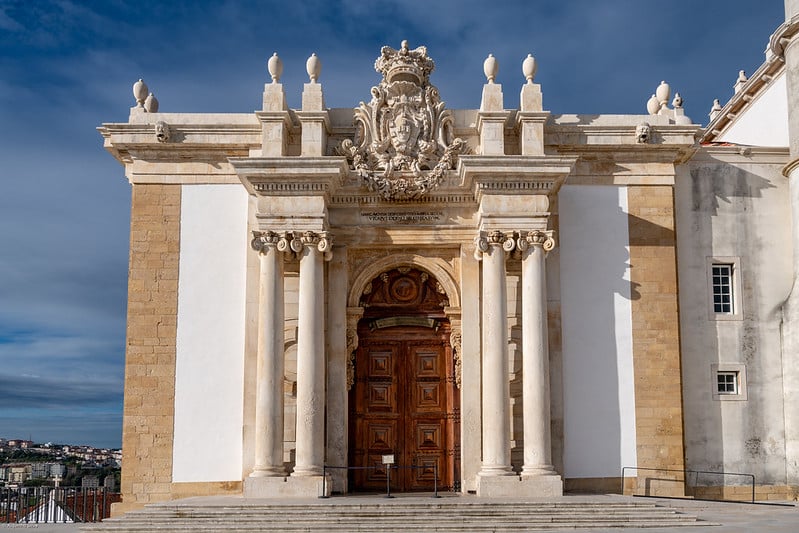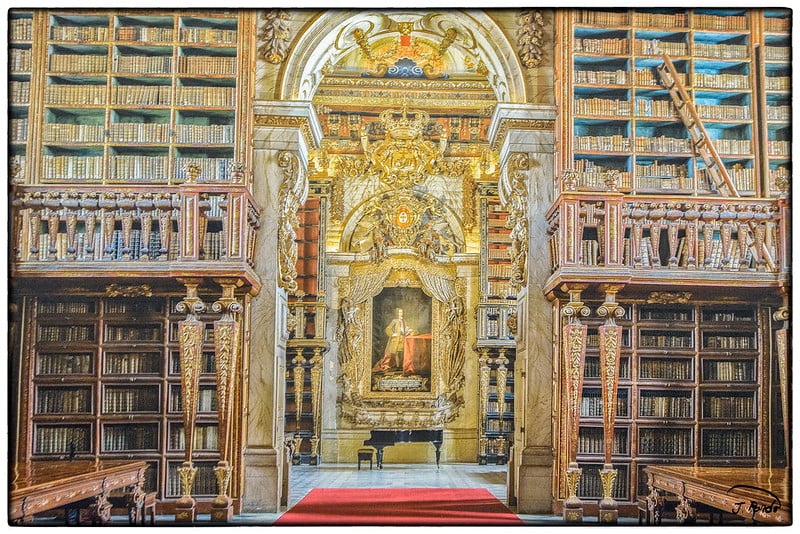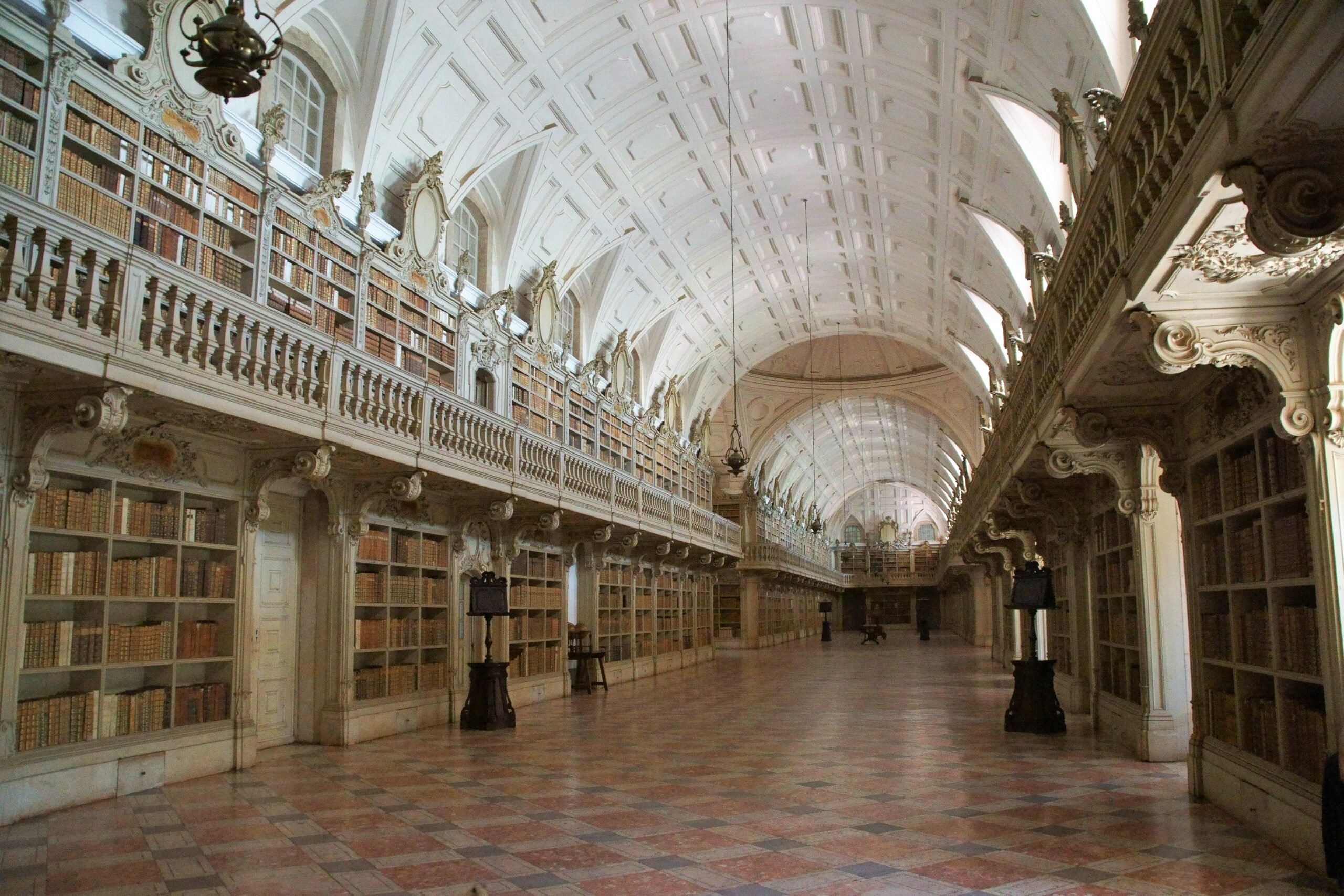Nestled in the heart of Portugal, the Joanina Library is a haven for any bibliophile, student, or scholar. With its rich collection of ancient books and Baroque architecture, the library makes for a time-traveling machine that allows you to explore the country’s literary heritage!
Seeing the intricacies of this library and discovering how workers preserve the books is truly a once-in-a-lifetime experience. Furthermore, the Joanina Library is part of the University of Coimbra. It is also an architectural, historical, and academic treasure.
We won’t even mention the city of Coimbra – it goes without saying that anyone who wants to fully immerse themselves in the culture and history of Portugal should consider visiting it!
Without further ado, let us convince you why visiting the Joanina Library is a must! Keep reading to learn more about its history, design, structure, location, and ticket prices (as well as some fascinating details about a bat colony residing in the library!).
The Joanina Library – History, Design, and Structure
The Joanina Library was built between 1717 and 1728. It was named after King John V of Portugal, who ordered its construction during the Age of Enlightenment. The library received its first books in 1750. Today, almost three centuries later, it has more than 70,000 books and is one of the richest European libraries.
Preserving books is an art in itself. Therefore, the architects had foreseen that this building would need extra protection.
The Joanina Library has thick walls measuring 2.11 meters (6.9 feet). The door is made of teak, thus ensuring that the temperature inside the building stays between 18 and 20 degrees Celsius (64.4-68 degrees Fahrenheit). These walls prevent the extra humidity and hot sun rays from reaching the 200-century-old books. Besides this, the bookshelves are made from oak, which is excellent at keeping insects away.
Today, the library building is often called a vault due to its special structure.
The Joanina Library has three floors:
- The Noble Floor. It has three halls filled with bookshelves adorned with paintings and carvings that will hypnotize you (as if the books weren’t enough!). In addition, you’ll delight in the gorgeous archways that connect these halls. The ceiling of this floor is decorated with figures and messages linked to the ideals and principles of the University of Coimbra. Most of the books that reside on the Noble Floor date from the 15th-18th centuries.
- The Middle Floor. The Middle Floor once served as the place where ancient books were cleaned, restored, and cataloged. It may have also served as a home for the guards who watched over the academic prison and for members of the academic community. This floor opened to the public only in 2010.
- The Prison. The University of Coimbra once had its own legislation and governed itself. As such, it seems only natural that it had its own academic prison, right?! The prison that is part of the University of Coimbra Baroque library building is the oldest medieval prison in Portugal. It has two narrow cells and a winding staircase. At the end of the 18th century, Maquis de Pombal ordered the construction of communal cells, a prayer room, latrines, and a visiting room.

The Bat Colonies of the Joanina Library
Here’s another interesting fact you probably do not want to know if you have chiroptophobia – the building has been home to two colonies of bats for more than two centuries!
These mammals are part of the administration and help keep insects and other pests away. Every night, the library workers cover the tables with fabric made from animal skin to prevent the bats from damaging them. Sounds a bit spooky, doesn’t it?!
If you’re afraid of bats, there’s no need to remove the library from your schedule. It’s highly unlikely you’ll ever see them – after all, bats are nocturnal creatures.
If you don’t mind a bit of chirping and squawking though, we recommend visiting the library as early as possible in the morning or in the late afternoon. Sometimes the bats can be heard throughout the walls. If they decide to remain silent, you’ll definitely hear them if you wait outside the library until the sun sets.
The Joanina Library – Location and How to Get There
The Joanina Library is located between Parque da Cidade Manuel Braga and Jardim Botânico Da Universidade de Coimbra.
If you need to reach Coimbra from Lisbon or Porto, you can always take a train or a bus. If you’re in Lisbon, for example, you can take a train from the Oriente station. Quite a few are heading to Coimbra daily, so you’ll definitely find one that fits your schedule. The tickets cost roughly 20–30 EUR.
If you’re in Porto, you should head to the São Bento station. This way, you’ll kill two birds with the same stone – you’ll delight in the incredible azulejo tiles of the famous São Bento station and then begin your journey to Coimbra!
For further details regarding train routes and prices, check the official Comboios de Portugal website.
If you prefer to travel by bus – not a problem! There are plenty at the Oriente station in Lisbon heading to Coimbra, and they’re even cheaper than the train! If you’re taking a bus from Porto, you should go to the Campanhã station. Click here for more details about bus schedules and tickets.

The Joanina Library – Ticket Prices
If you want to visit the Joanina Library, you have two options: you can visit it by yourself or book a guided visit.
Here are the regular visits you can book a ticket for:
- The University and the Joanina Library – 13.5 EUR. It includes the Library, the Royal Palace, Saint Michael’s Chapel, the Chemistry Laboratory, and the Academic Museum.
- The University of Coimbra and P.O.RO.S Municipal Museum – 16.5 EUR. It includes the Library, Saint Michael’s Chapel, the Royal Palace, and the Municipal Museum P.O.RO.S.
If you want a guided tour, you can choose one of the following options:
- Guided Tour to the Palace of Schools – 20 EUR. It includes the Library, the Royal Palace, and Saint Michael’s Chapel and lasts for about one hour and a half. The tour is offered in Portuguese and English.
- Guided Tour to Botanical Garden – 10 EUR. It includes only the Botanical Garden of the University of Coimbra.
- Guided Tour to the Botanical Garden Greenhouse – 10 EUR. It includes the Greenhouse of the Botanical Garden, where you can explore the tropical collections – perfect for wildlife enthusiasts!
Since the opening hours usually change during the summer and winter, we strongly recommend checking with the University before planning your trip or buying a ticket. Besides, if you want a guided tour, you’ll have to check their availability. There are usually only a few tours a day, so you’ll have to see if their schedule suits your trip plans.
Mafra Palace Library – Another Bat-Infested Library
What if we told you that Portugal had the world’s only two libraries infested with bats on purpose? One of them is the Joanina Library – you already know everything about it. The other is in the south of the country – the Mafra Palace Library.
The Mafra Palace Library is one of the world’s most famous destinations for bookworms and scholars! No wonder the administration goes the extra mile to preserve its rich collection of books! It is believed that the Mafra bat colony has been living in the Mafra Palace for several centuries, although it would be impossible to state when exactly they became part of the staff. The colony includes gray long-eared bats and serotine bats.

Other Landmarks to Visit in Coimbra
Are you staying in Coimbra for a few more days? Excellent! Here’s what we recommend visiting:
- Portugal dos Pequenitos – a miniature park located in Santa Clara e Castelo Viegas, Coimbra.
- Santa Cruz Church – a National Monument in Coimbra and an excellent example of Portuguese Manueline architecture.
- Sé Velha, the Old Cathedral of Coimbra – an iconic landmark in Portugal built in the Romanesque style.
- The National Museum Machado de Castro – an art museum named after Joaquim Machado de Castro.
- Mondego’s Verde Park – an excellent destination for a warm spring afternoon.
- Monastery of Santa Clara-a-Nova – a monastery built in the 17th and 18th centuries and a National Monument of Coimbra featuring a Baroque architectural style.
- Jardins da Quinta das Lágrimas – it is located in Quinta das Lágrimas and is a true gem for plant enthusiasts; there’s also a palace that now functions as a luxury hotel (just in case you want to spend a weekend in an exquisite location).
- Conimbriga – located just 25 minutes outside Coimbra, Conimbriga is the country’s largest Roman site, where you can see Europe’s most well-preserved mosaics.


